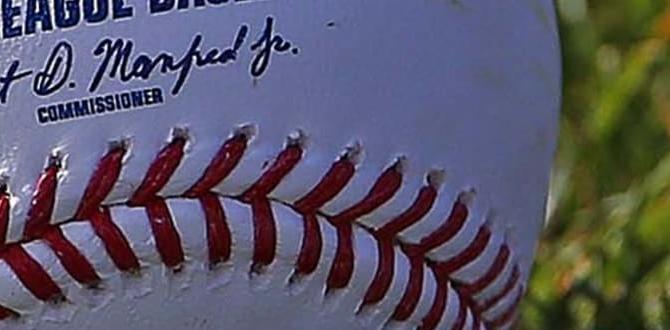Quick Summary: Wondering about minor league baseball salaries? While not millions, pay scales vary by league, experience, and team. Rookies can expect a few hundred dollars a week, increasing with performance and higher classifications. Understanding this pay structure is key for aspiring pros and fans alike.
Hey everyone, John P. Miller here from FriskMode! Ever wonder what those up-and-coming baseball stars are actually making as they chase their big league dreams? It’s a question a lot of aspiring players, their families, and even dedicated fans have. The reality of minor league baseball pay can be a bit of a surprise, and it’s often not what you see in Hollywood movies. It can feel a little confusing to figure out the exact numbers. In this guide, we’re going to break down the pay scale for minor league baseball so you get a clear picture. We’ll cover everything from what rookies earn to how your pay might change as you climb the ranks. Ready to get the inside scoop?
Understanding the Minor League Baseball Landscape
Minor League Baseball (MiLB) is a dynamic system that serves as the proving ground for future Major League stars. It’s divided into several levels, or classifications, each with its own set of rules and, importantly, its own pay structure. Think of it like a ladder; each rung represents a different level of development and, generally, a step up in compensation. These levels are crucial to understand because they directly impact the financial reality for players grinding it out in the minors.
The journey through MiLB is tough. Players spend long hours traveling, practicing, and playing, often far from home, with the ultimate goal of reaching the majors. While the passion for the game is immense, the financial aspect is a significant reality for these athletes. It’s a crucial part of their development and a factor that influences career decisions. Recognizing the different leagues and their typical pay is the first step in understanding this complex system.
The Different Tiers of Minor League Baseball
Before we dive into the numbers, it’s essential to identify the various levels within Minor League Baseball. These classifications have evolved over time, but generally, they progress from Short-Season leagues designed for younger players and international signees, up through Rookie leagues, Class A, High Class A, Double-A, and finally, Triple-A, which is the closest level to Major League Baseball. Each level signifies a step up in the quality of competition and the development stage of the players.
- Rookie Leagues: Often the first professional stop for drafted players and international signees. These leagues focus on fundamental development.
- Class A (Low-A): Players here are typically more established than in Rookie leagues, working on refining their skills.
- High Class A: A step up in competition, featuring more advanced prospects.
- Double-A (AA): This is often considered a significant hurdle, where players are closer to MLB readiness and facing tougher competition.
- Triple-A (AAA): The final stop before the majors. Players here are often one injury call-away from playing in MLB.
It’s worth noting that Minor League Baseball underwent a significant restructuring in 2021. The affiliated leagues are now organized differently, often aligned more directly with MLB teams’ geographical locations and development needs. This realignment brought changes to team structures and league names, but the hierarchy of development and pay generally remains similar, with Triple-A still being the highest rung.
What is the Typical Pay for Minor League Baseball Players?
The question of “How much do minor league baseball players make?” doesn’t have a single, simple answer. The pay scale for minor league baseball is influenced by several factors: the league classification, the player’s experience, their performance, and sometimes, the specific contract negotiated with the team. However, there are established minimums set by Major League Baseball, and actual salaries can vary based on the team’s resources and the player’s perceived potential.
For many players, especially those in the lower levels, the salary is more of a stipend than a living wage. It covers basic expenses while they focus on their development. The goal for most is not to get rich in the minors, but to earn a spot in the big leagues, where the financial rewards increase dramatically.
Salary Breakdowns by League Classification
Let’s break down the approximate weekly or monthly pay players can expect at different levels. These figures are averages and can fluctuate. A significant portion of a minor leaguer’s compensation also comes in the form of benefits, such as housing, meals, and travel expenses, especially at the lower levels.
| League Classification | Estimated Weekly Pay (Approximate) | Estimated Monthly Pay (Approximate) |
|---|---|---|
| Rookie Leagues | $300 – $600 | $1,200 – $2,400 |
| Class A (Low-A) | $500 – $700 | $2,000 – $2,800 |
| High Class A | $600 – $800 | $2,400 – $3,200 |
| Double-A (AA) | $700 – $1,000 | $2,800 – $4,000 |
| Triple-A (AAA) | $800 – $1,200+ | $3,200 – $4,800+ |
These numbers reflect a base pay. Players who have been drafted multiple times, been in professional baseball for several years, or are considered top prospects might command slightly higher salaries within these ranges, or even above them. The Collective Bargaining Agreement (CBA) between Major League Baseball and the Major League Baseball Players Association (MLBPA) sets minimum salary standards, which these figures generally adhere to.
It’s important to remember that these salaries are typically for the active playing season, which usually runs from April through September. This means players are often only receiving consistent pay for about six months of the year. While some players might sign minor league contracts that include year-round pay, it’s less common, especially at the lower levels.
Factors Influencing Player Salaries
Several elements come into play when determining what a minor league player earns:
- Experience Level: A player in their first year out of the draft will typically earn less than a veteran who has spent years in the minors and is on their third or fourth minor league contract.
- Draft Position: High draft picks, especially those selected in the first few rounds, often receive signing bonuses that can supplement their minor league salary. While the signing bonus is a one-time payment, it reflects their perceived value and potential.
- Performance and Potential: Players who consistently perform well and show significant potential for growth are more valuable to their organization. This can translate into slightly better contracts when negotiations occur.
- The MLB Organization: Some MLB teams have deeper pockets and may offer slightly more competitive contracts or better amenities for their minor league affiliates.
- Contract Type: Minor league contracts can vary. Some are straight salary, while others might include incentives for performance or advancement.
The Role of Signing Bonuses
For drafted players, especially those selected early, signing bonuses are a significant part of their initial professional compensation. These bonuses are non-negotiable and are paid out over time, usually tied to specific dates or milestones. A top-five pick might receive a signing bonus well into the millions, while a late-round pick might get a bonus closer to $10,000 – $30,000. This bonus is separate from their weekly or monthly salary and is designed to compensate them for foregoing college eligibility or other opportunities.
These bonuses are a crucial part of attracting talent to sign professional contracts. While they don’t directly affect the weekly pay for playing games, they represent a substantial financial commitment from the MLB club and a significant financial windfall for the player early in their career.
Beyond the Base Salary: What Else Do Minor Leaguers Get?
The pay scale for minor league baseball is only part of the financial equation for these athletes. Because the base salaries are often modest, organizations provide a range of other benefits to support their players. These benefits are essential for allowing players more freedom to focus on development rather than worrying excessively about day-to-day expenses.
Housing and Meals
One of the biggest expenses for any individual is housing. In many parts of the country, especially in areas where minor league teams are located, rent can be substantial. To alleviate this burden, most minor league organizations provide housing for their players. At the lower levels (Rookie, Class A), this often means staying with host families who volunteer to house players, generally for a small stipend or in exchange for meals. At higher levels, teams might provide shared apartments or housing complexes for players.
Similarly, meal money or per diems are provided. Players are typically given a set amount each day to cover food costs. This can range from $30 to $60 per day, depending on the league and team. This helps ensure players have access to nutritious food to fuel their demanding game schedules. For players on the road, this per diem is especially critical for covering the costs of eating at restaurants or buying groceries in different cities.
Travel Expenses
The life of a minor leaguer involves a great deal of travel. Teams move from city to city, often by bus, especially at the lower levels. While the cost of transportation itself is covered by the organization, players are expected to manage their personal comfort and needs during these journeys. This means the per diem for meals becomes even more important when you’re on a 10-hour bus ride between games.
Equipment and Gear Stipends
While teams usually provide essential team equipment like uniforms, catcher gear for catchers, and some basic training aids, players are often responsible for their personal playing equipment. This includes their gloves, bats (though some players have bat sponsors), batting gloves, cleats, and other accessories. Some organizations may provide a small annual stipend or allowance for players to purchase this gear, which can range from a few hundred to a thousand dollars per year, depending on the team.
For players needing specialized gear, like a specific type of catcher’s mitt or a personalized bat model, having a small equipment budget is extremely helpful. It allows them to use equipment they feel most comfortable with, which is crucial for performance.
Health Insurance and Medical Care
Minor league players are typically covered by health insurance provided by their affiliated Major League Baseball club. This is an essential benefit, as injuries are common in professional sports. Access to medical staff, trainers, and physical therapy is provided throughout the season. This ensures that players can receive the care they need to recover from injuries and stay in playing shape, without incurring massive medical bills. Having this safety net is a significant relief for players and their families.
What About Players Not on MLB Contracts?
It’s important to distinguish between players on MLB-affiliated minor league contracts and those who play in independent baseball leagues. Independent leagues operate separately from Major League Baseball and do not have the same salary structures or benefits. Players in these leagues often earn significantly less, and the provision of housing, meals, and travel can vary greatly.
The pay in independent leagues can be as low as $300-$500 per week, sometimes even less, and players are often responsible for their own housing and meals. While the dream of reaching the majors is still present for many in independent ball, the financial realities are often more challenging.
Financial Planning for Minor League Players
Given the modest salaries and the seasonal nature of the work, financial planning is crucial for minor league baseball players. Many players come from humble backgrounds, and the transition to professional life requires discipline and smart management of their earnings.
Budgeting and Saving
The first step for any minor league player is to create a detailed budget. Given that salaries are relatively low and seasonal, knowing where every dollar goes is vital. Players need to account for personal expenses, potential unexpected costs, and begin saving as much as possible. This early habit of saving can be incredibly beneficial for their long-term financial health, even if they don’t reach the major leagues.
Understanding Taxes
Players are responsible for paying taxes on their income. This includes their salary, any signing bonuses, and even some forms of per diems in certain situations, depending on tax laws. It’s advisable for players, or their families, to seek professional tax advice to ensure they are complying with all regulations and taking advantage of any potential deductions. Organizations often provide resources or recommend tax professionals who are familiar with the unique financial situation of athletes.
Investing in Their Future
For players with aspirations beyond baseball, or for those who face early career endings due to injury or performance, investing in their future is key. This could mean using any signing bonus strategically, saving aggressively from their minor league salaries, or exploring educational opportunities. Major League Baseball offers various programs and resources aimed at helping minor league players develop professional skills or pursue education outside of baseball, which can aid in this transition.
The Road to the Show: Player Salaries in Major League Baseball
While the focus here is on the minor league pay scale, it’s worth briefly touching on the contrast with Major League Baseball salaries. The financial gulf between the minors and the majors is immense. A player’s first MLB contract, even for someone who isn’t a star, typically guarantees a salary significantly higher than any minor league contract. MLB minimum salaries have steadily increased over the years, reaching over $700,000 in recent seasons according to MLB.com.
Stars can earn tens or even hundreds of millions of dollars through multi-year contracts. This lucrative potential is the ultimate carrot that drives players through the challenging and often underpaid years in Minor League Baseball. The hope of playing in the big leagues is not just about the love of the game or the prestige; it’s also about finally achieving financial stability and immense earning potential.
For a deeper dive intoMLB contract structures and salaries, resources like the MLBPA website or financial sports news outlets often provide detailed breakdowns.
FAQ: Your Minor League Baseball Pay Questions Answered
Q1: How much does a rookie minor league baseball player make per week?
A: A rookie minor league baseball player typically earns between $300 and $600 per week, depending on their league classification. This is often supplemented by housing, meals, and travel provided by the organization.
Q2: Does the pay increase significantly as players move up through the minor league levels?
A: Yes, the pay generally increases with each higher classification. Players in Double-A and Triple-A earn considerably more than those in Rookie or Class A leagues.
Q3: Are housing and meals included in minor league pay?
A: Yes, housing and meals (or meal money/per diems) are standard benefits provided to minor league players, especially at lower levels, to help offset living expenses.
Q4: What about players who don’t get signed to an MLB contract?
A: Players not signed to an MLB-affiliated contract often play in independent leagues, where salaries are typically lower, and benefits like housing and meals may not be provided.
Q5: Do signing bonuses affect a player’s weekly salary?
A: Signing bonuses are separate from weekly salaries. They are a one-time payment for signing, reflecting a player’s draft position and potential, and do not directly alter their game-day pay.
Q6: Is there a minimum salary set for minor league players?
A: Yes, Major League Baseball, in conjunction with the MLB Players Association, sets minimum salary standards for players based on their years of professional service and league classification.
Q7: How does a player’s role on the team (starter vs. reliever) affect their pay?
A: While specific contract details can vary, a player’s primary role on the field typically has less impact on their base salary than their experience level, draft position, and potential. Performance incentives, however, could theoretically be tied to such factors.
Conclusion
The journey through Minor League Baseball is one of immense dedication, sacrifice, and talent. Understanding the pay scale for minor league baseball reveals a system where passion often outweighs profit, especially in the early stages of a player’s career. While salaries are modest, the comprehensive benefits package of housing, meals, and travel support allows players to focus on honing their skills. For those who persevere and achieve their dream of reaching Major League Baseball, the financial rewards can be life-changing. For aspiring players, coaches, and fans, this insight into the financial realities of the minor leagues offers a deeper appreciation for the commitment and determination required to play the game at every level.





